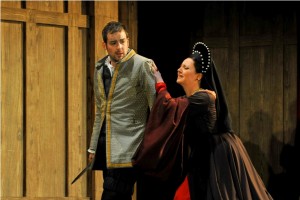The title of Donizetti’s Anna Bolena tells all: one of the most fascinating, contradictory, and unintentionally influential figures in British history, Anne Boleyn, serves as the inspiration for a nineteenth-century opera that provides acres and acres of territory for vocal showmanship, at the same time weaving a tale of betrayal, lust, power, and love that ranks among the greatest in the operatic repertoire. Although this may sound like the blurb for a historical romance novel, that’s what opera, ultimately, is all about.
History buffs who attend Dallas Opera’s production, which opened Friday night at Winspear Opera House, will do well to leave their purist instincts at the door. Donizetti and his librettist Felice Romani preserved the central facts—that Henry VIII, having wantonly disposed of his first wife, Catherine of Aragon, and replaced her with Anne Boleyn (in the process, producing the history-changing schism of the Church of England and the Church of Rome) decided barely three years later to replace Anne with Jane Seymour. Donizetti and Romani focused on the love and conflict between Anne (Anna in the opera) and Jane (Giovanna), enriching this central dilemma with the orbiting interactions of Henry VIII (Enrico), the court musician Smeton, Anna’s brother Lord Rochefort, Anna’s former lover Lord Percy, and a court official, Hervey.

Mezzo-soprano Denyce Graves, one of the greatest operatic performers of our time, has the presence for the part of Giovanna but a voice that was far too heavy for this bel canto role. Armenian soprano Hasmik Papian in the title role was likewise at times weighted down by the sheer force of her voice. However, both overcame this inherent challenge beautifully in the duet at the beginning of Act II, a dramatic and musical tour-de-force. Papian went on to present an equally memorable final scene.
The other primary and secondary roles—each of which, in Anna Bolena, is gigantic—were brilliantly fulfilled by tenor Stephen Costello as Percy, bass Oren Gradus as Enrico, mezzo-soprano Elena Belfiore as Smeton, bass Mark McCrory as Rochefort, and tenor Aaron Blake as Hervey. Gradus was a particularly arresting presence as the evil Enrico, and Belfiore was both convincing and compelling in the tricky pants role of Smeton.
Director Stephen Lawless clearly understands the tension of music and drama in this remarkable work, and brought the Tudor era as seen through the eyes of early nineteenth-century romanticism to life consistently .The introduction of Princess Elizabeth, the future Elizabeth I, in the form of a silent adolescent girl (though the historical Elizabeth was less than three years old at the time of the events that inspired the opera) was the most striking of many remarkable touches by Lawless.
The sets, by Benoît Dugardyn, were both wonderful and bothersome. Dugardyn created a Globe Theater-type arena for the action, with, unfortunately, huge noisy moving panels which, while providing flexible spaces, tended to overwhelm the production visually. Likewise, the costumes by Ingeborg Bernerth and Juila Müer, were at times wonderfully insightful, as in the transformation of Anna from a scarlet-wearing woman of the world to a white-clad madwoman-saint, or Enrico’s constant shift from a rough-hewn thug to a bejeweled king. However, the principal males were adorned with overly noticeable codpieces—particularly ludicrous and disconcerting on Belfiore, for obvious reasons.
The company’s music director Graeme Jenkins as always found the impetus and color that so often evades other conductors in the music of Donizetti, turning a work that has a reputation as a showpiece into a powerful drama.
Top photo: Denyce Graves (front) as Jane Seymour and Hasmik Papian in the title role (photo by Karen Almond for the Dallas Opera).





